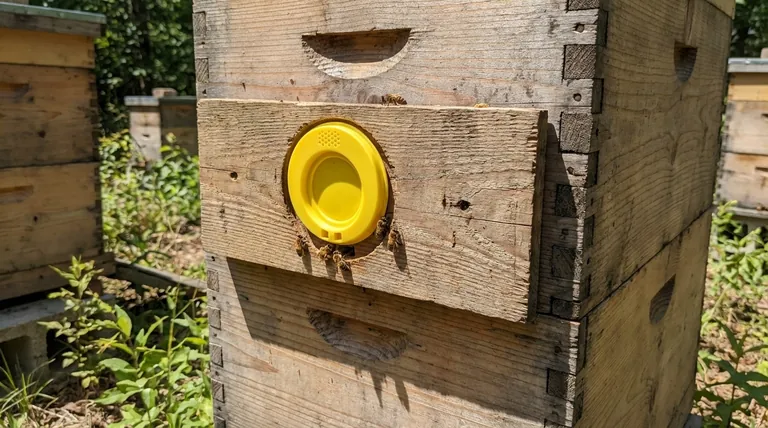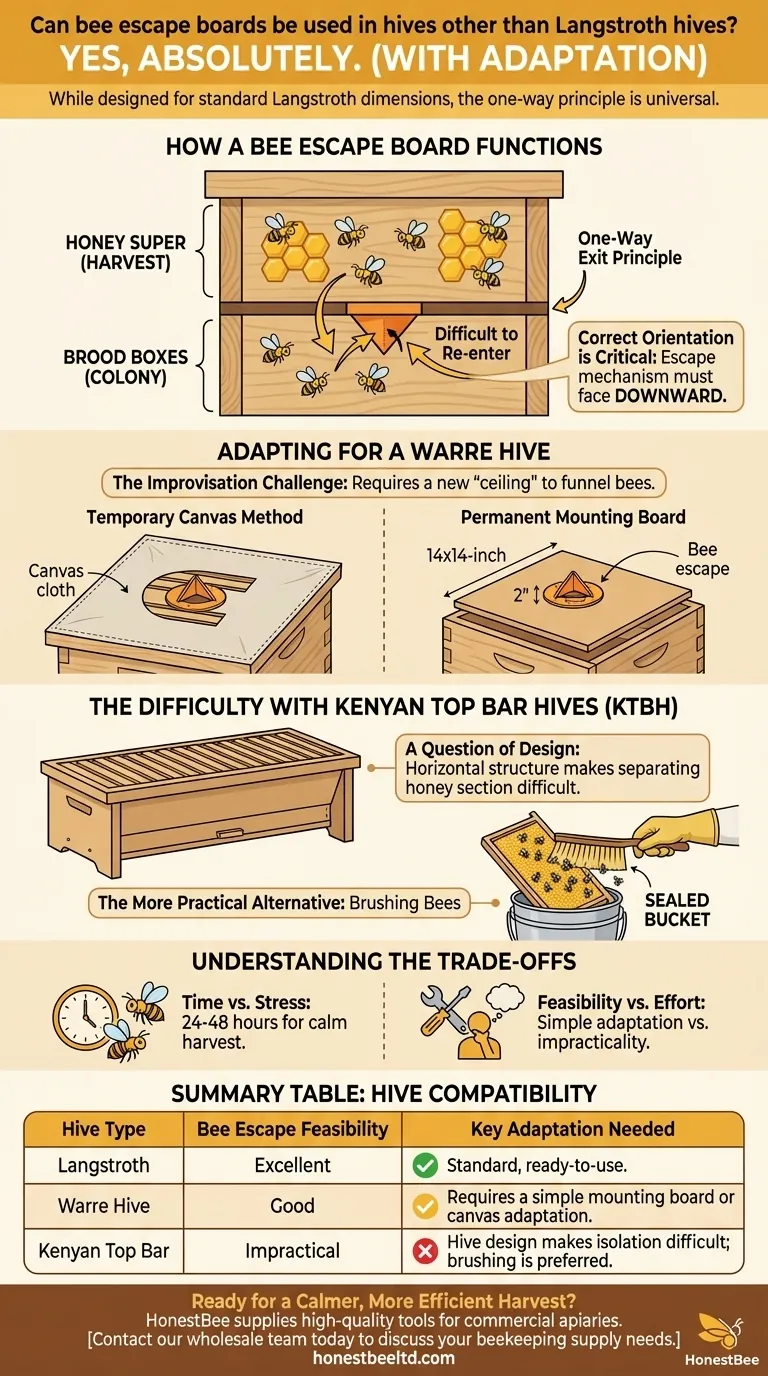Yes, absolutely. While bee escape boards are designed with the dimensions of a standard Langstroth hive in mind, the principle behind them is universal. You can successfully adapt and use them in other hive types, such as Warre hives, although it requires some simple improvisation. For other designs, like the Kenyan top bar hive, it is technically possible but often impractical.
The core challenge isn't whether the one-way escape mechanism will work—it will—but rather how to physically install the board to create a bee-proof seal in a hive that lacks the standardized dimensions of a Langstroth super.

How a Bee Escape Board Functions
The One-Way Exit Principle
A bee escape board is essentially an inner cover fitted with one or more one-way exits. Worker bees can easily travel down and out of the honey super through the escape but find it difficult or impossible to re-enter.
Correct Orientation is Critical
To function, the board is placed between the honey super you intend to harvest and the brood boxes below it. The side of the board with the escape mechanism, often a screened triangle or a maze-like plastic insert, must face downward toward the main part of the hive.
Adapting the Board for a Warre Hive
The Improvisation Challenge
Warre hives do not use the same inner covers as Langstroth hives, so you cannot simply drop in a standard escape board. You must create a new "ceiling" for the bees below the honey super that funnels them through the escape.
The Temporary Canvas Method
A straightforward approach involves using the hive's separator canvas. You can cut a 'C' shaped flap in the canvas that is roughly the size of your bee escape. When you lay the canvas over the top bars, you place the escape device over the opening, forcing bees to exit through it.
The Permanent Mounting Board
For a more durable solution, you can construct a dedicated mounting board. A 14x14-inch sheet of solid material, like thin plywood, with a 2-inch hole drilled in the center works perfectly. You can then attach the bee escape over this hole, creating a reusable board for every harvest.
The Difficulty with Kenyan Top Bar Hives
A Question of Design
Using a bee escape in a Kenyan top bar hive (KTBH) is significantly more difficult due to its horizontal design. Honey is harvested one bar at a time, not by removing an entire box. There is no simple way to separate the "honey section" from the rest of the hive with a single board.
The More Practical Alternative
Because of this structural challenge, most KTBH beekeepers do not use bee escapes. The common and more efficient method is to lift each honey-filled comb, gently brush the bees off with a bee brush, and immediately place the comb into a sealed bucket to prevent robbing.
Understanding the Trade-offs
Time vs. Stress
The primary benefit of a bee escape is that it creates a calm and gentle harvest. It takes 24-48 hours to clear a super, but it results in very few agitated bees.
Feasibility vs. Effort
For a stackable, vertical hive like a Warre, the small amount of effort to create an adapter board is often well worth the reward of a peaceful harvest.
The Practical Limit
For a horizontal hive like the KTBH, the complexity of trying to isolate individual combs makes the bee escape method impractical. The direct method of brushing bees off, while more disruptive, is far more efficient and logical for the hive's design.
Making the Right Choice for Your Hive
- If you use a Warre hive: A bee escape is an excellent, low-stress harvesting method, provided you create a simple mounting board or adapt your separator canvas.
- If you use a Kenyan top bar hive: Brushing bees from each comb is the most practical and widely accepted method due to the hive's horizontal structure.
- If your primary focus is minimal bee disturbance: The bee escape is the superior tool for any hive where its installation is physically feasible.
Understanding your specific hive's design is the key to choosing a harvesting method that is both effective for you and calm for your bees.
Summary Table:
| Hive Type | Bee Escape Feasibility | Key Adaptation Needed |
|---|---|---|
| Langstroth | Excellent | Standard, ready-to-use. |
| Warre Hive | Good | Requires a simple mounting board or canvas adaptation. |
| Kenyan Top Bar | Impractical | Hive design makes isolation difficult; brushing is preferred. |
Ready for a Calmer, More Efficient Harvest?
At HONESTBEE, we supply commercial apiaries and beekeeping equipment distributors with the high-quality tools needed for successful operations. Whether you manage Langstroth, Warre, or other hive systems, having the right equipment is key to a productive season.
Let us help you equip your business for success. Contact our wholesale team today to discuss your beekeeping supply needs.
Visual Guide

Related Products
- Circular Labyrinth Bee Escape for Efficient Hive Management
- HONESTBEE Wooden Bee Escape Board with Triangle Mesh Design for Beekeeping
- HONESTBEE Multi Exit Plastic Bee Escape Board for Efficient Honey Harvesting
- HONESTBEE 4-Way Metal Corner Wooden Bee Escape Board
- Wooden Queen Bee Excluder for Beekeeping
People Also Ask
- How long should a bee escape be placed before harvesting honey? The 24-48 Hour Guide to a Stress-Free Harvest
- What happens if an escape board is left on for too long? Avoid this common harvesting mistake
- How long should you wait after placing a bee escape board before harvesting honey? Clear Your Supers in 24-48 Hours
- What is the purpose of a bee escape board? A Gentle, Chemical-Free Way to Harvest Honey
- What is a bee escape and why is it used in beekeeping? A Guide to Gentle Honey Harvesting



















